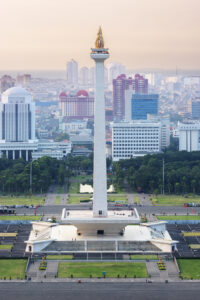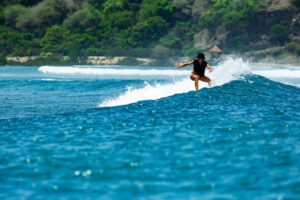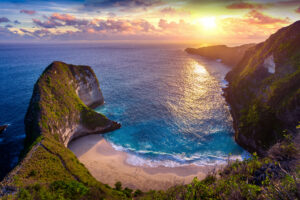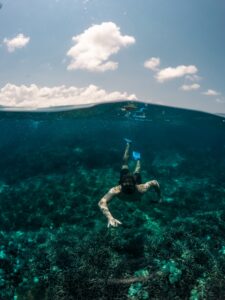Bunaken National Marine Park – Details and Facts
Bunaken National Marine Park
Bunaken Marine Park was one of the first of Indonesia’s increasing system of marine parks, having been established in 1991. Bunaken, Manado Tua, Siladen, Montehage, and Nain are the five islands that make up the archipelago. It is a part of the Indo-Pacific region, which provides a supportive environment. The Park, which spans little under 80,000 hectares of land (3%) and sea (97%) in Manado, Indonesia, is located in the province of North Sulawesi. The mesmerizing water is transparent and attractive.
In this article, you will find all the details about Bunaken National Marine Park. So don’t stop and read on.
How to get to Bunaken National Marine Park?
Bunaken National Park is accessible via Manado’s port, the Marina Nusantara Diving Centre (NDC) in the Molas District, and the Marina Blue Banter. Take a flight to Manado and then a boat to Bunaken, which takes 45-60 minutes. A motorboat ride from Manado to Siladen Island takes about 20 minutes, 30 minutes to Bunaken Island, 50 minutes to Montehege Island, and 60 minutes to Nian Island. You can book a boat via your resort, or there is a public boat that runs from Manado to Bunaken every day (except Sunday) at roughly 2-3 p.m. Take the public boat from the Manado market’s north side. Foreign travelers will pay 25,000 Rp one way, while locals would pay 10,000 Rp. At roughly 8-8.30 a.m., you can return by boat via the Bunaken village jetty. It will take 10-15 minutes for tourists to go from Blue Banter Marina to the tourist spots on the island of Bunaken on a yacht that is available, however, it would take 20 minutes to travel to the diving spot from NDC on a speed boat.
Flora and Fauna of Bunaken National Marine Park
Fish such as the gusumi horse (Hippocampus horse), white oci (Seriola rivoliana), yellow tail lolosi (Lutjanus kasmira), goropa (Ephinephelus spilotoceps and Pseudanthias hypselosoma), ila trunk (Scolopsis bilineatus), and others can be found in the waterways of Bunaken National Park.
Sulawesi black macaques (Macaca nigra nigra), deer (Cervus timorensis russa), and polecat (Macaca nigra nigra) are among the animal species found on the mainland and along the coast (Ailurops ursinus ursinus). Sonneratia sp., Rhizophora sp., Lumnitzera sp., and Bruguiera sp. are some of the mangrove plant species found in Bunaken National Park. This forest is home to a diverse range of crabs, shrimp, mollusks, and seabirds, including Heron, storks, sea drove, and seagulls.
Where to stay in Bunaken National Marine Park?
Some tourists choose to stay in Manado and take day trips to Bunaken Island, however staying on the island itself is highly recommended if you have the time. There are numerous hotels and dive resorts to pick from, and diving is the greatest way to explore the sea here if you are interested. The Bunaken Cha Cha Nature Resort, a beautiful villa by the sea with its own private beach, is one of the most popular resorts here. Dive trips can also be organized from this location. Bunaken Kuskus Resort and Cicak Senang Resort are good beachside resorts with a homestay feel for people on a budget.
What makes the Bunaken National Marine Park so special?
Bunaken is home to unique and endangered wildlife such as coelacanths, dugongs, whales, and turtles, as well as dolphins, in addition to its vast variety. The Park was formed because of the maritime biodiversity it sustains, its location on a migratory path for protected creatures, and its economic worth for fisheries and tourism. Over 20,000 people in the surrounding area rely on the park’s natural resources. The concern was that if the area was left unmanaged, overfishing, harmful fishing techniques, and unrestricted pollution would devastate the marine habitat, putting everyone at risk.
Tourists scuba diving in Bunaken Island are drawn to the park because of its unique bathymetry. Because there is no continental shelf in the northern region of North Sulawesi, the coastline area drops straight to the seafloor. In the park, there are at least 58 different genera and subgenera of corals. A total of 2,000 distinct fish species are thought to exist. Between Manado Tua and Montehage, the deepest water is roughly 1,360 meters. Bunaken has over 25 diving sites.
What to do in Bunaken National Marine Park?
The most important thing to do here is dive! You have a choice of 20 dive locations where you may expect to see a variety of hard-to-find aquatic life. Be aware that portions of the walls are steep, and the current may be powerful and change quickly. If diving snorkel isn’t your thing, you’ll be pleasantly surprised at how much marine life there is in the shallows. Hiking to some of the more remote places is possible, but routes are not well defined, so ask the locals first. Dolphin and whale viewing cruises can be combined with diving expeditions, or you can hire a boat privately. Simply relax on the beach and take in the gorgeous sun, oceans, and breeze.
Visitors Contribution to Bunaken National Marine Park
As a scuba diver visiting Manado’s sights, you are certainly contributing to the local economy by spending money on meals, transportation, lodging, and shopping. If you are an environmentally conscious diver, your presence will have no harmful impact on Bunaken’s marine park. In reality, your presence is one of the reasons Bunaken Island is protected, and all divers are required to pay a park admission fee, which contributes to the good influence visitors have. In reality, the diving industry provides an alternative source of income for many locals who would otherwise be fishermen. The Bunaken National Park Management Advisory Board manages all proceeds from the sale of entrance tags and tickets. This money will be used by the BNPMAB to fund a number of high-priority conservation programs in the park.
Patrols and enforcement to eliminate destructive fishing practices like blast and cyanide fishing, village improvement programs within the park, collection and disposal of plastic and other wastes entering the park’s waters, marine conservation education for both village children and adults, and reef and mangrove rehabilitation are just a few of these programs. Bunaken’s outstanding marine environments require financing, and your entrance charge is a significant contribution to the preservation of these incredible but endangered reefs.
FAQ: Frequently Asked Questions
What is the location of Bunaken National Marine Park?
Ans. Bunaken Marine Park is located in Northern Sulawesi, Indonesia.
Why Visit Bunaken National Marine Park?
Ans. Come here for diving and snorkeling, since its Aquatic National Park is home to a diverse array of marine life. It has an incredible variety of marine life, including 70 different coral species, five different sea turtle species, numerous fish species, and even white and blacktip reef sharks, dugongs, barracuda, and saltwater crocodiles!
When is the best time to Bunaken National Marine Park?
Ans. Because Indonesia has only two seasons, dry and wet, it is best to visit during the dry season to get the best view of the sea. May to September is the dry season. Keep in mind that this is peak season, so expect crowds and the weather to be scorching during the day.
Where to go nearby Bunaken National Marine Park?
Ans. Return to Manado for a city fix before heading west to places like the world-famous diving spot Raja Ampat or the stunning Maluku Islands. Otherwise, continue south to the Togean Islands for more diving.
What is the travel fee for Bunaken National Marine Park?
Ans. There is a daily fee of 50,000 Rp for the Marine Park (or 150,000 Rp per year if needed). Please pay at dive resorts, dive shops, or resorts, as appropriate, and receive your pass, which will be checked periodically.







